Marigolds are beautiful and easy-to-grow flowers, adding a splash of beautiful colors to any garden. Marigolds are popular with a wide range of hues, including; yellow, orange, pink, red, and blue. In this article, you’ll discover why marigolds are a must-have for your garden collections.
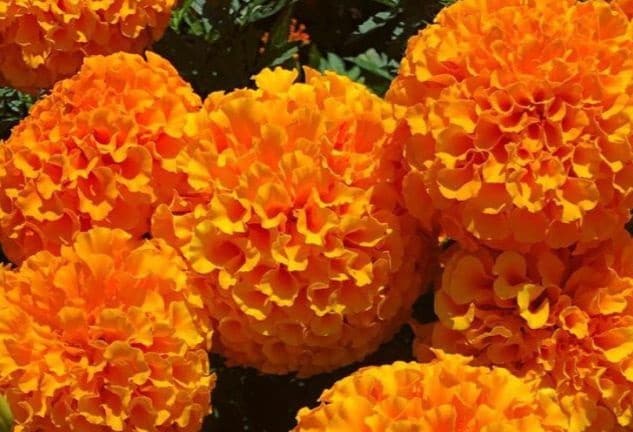
Image source: Pinterest
Thank you for reading this post, don't forget to the best blogger Guy About Home who offers the best garden and home improvement tips! If you are a home decor and design fan, don't miss the tips on home ideas. If you are a home garden owner, then you might be interest in our complete guides to house plants!
Marigold flowers are historical to Mexico and Guatemala and were extensively used by primitive cultures such as Aztecs, who attributed medicinal and religious qualities to the bloom. Today, it is a popular choice for gardeners worldwide due to its vibrant colors and unique characteristics.
Marigold flowers have over 50 varieties in nature, differing in colors, sizes, and shapes, depending on the variety. These flower colors range from yellow and orange to pink, red, blue, and even white, making them a versatile addition to your garden.
We will explore the beauty and benefits of growing marigold flowers, including tips on choosing the best ones for your garden and how to grow them successfully.
What Is Marigold Flower?
Marigold is a genus of flowering plants in the daisy family, Asteraceae. The flowers of marigolds are characterized by their vibrant colors, ranging from bright yellow and orange to pink, red, and even blue.
They typically bloom in the summer and fall and are known for their distinctive scent.
Marigold flowers are used for various purposes, including ornamental decoration, medicinal and culinary applications, and even cultural and religious ceremonies. They are easy to grow and maintain, making them a popular choice for gardeners of all levels.
What Do Marigold Flowers Mean?
Like many other flowers, marigolds have a rich history and cultural significance, contributing to their meaning and symbolism. Listed below are some of the most common meanings associated with marigold flowers:
#1 Joy and happiness
Thanks to their bright and cheerful colors, marigolds are often seen as symbols of joy and happiness.
#2 Love and affection
Marigold flowers can also be associated with love and affection, especially in some cultures where they are used as garlands or decorations during weddings and other romantic occasions.
#3 Remembrance
In some cultures, marigolds honor and remember loved ones who have passed away. They are often placed on graves or used in traditional Day of the Dead celebrations.
#4 Protection
Marigolds are believed to have protective properties in some cultures and are used in rituals to ward off evil spirits or negative energy.
Unique Characteristics of Marigold Flower
Marigold flowers are known for their unique characteristics, making them popular among gardeners worldwide. For ideas on how to beautifully decorate your home with marigold flowers, you want to ask an expert. Interestingly, speaking with Guy About Home will be best. We attend to home beauty and aesthetics. Check below for the most notable characteristics of marigold flowers:
#1 Easy to Grow
Marigold flowers are easy to grow and maintain, making them an excellent choice for beginner gardeners. They are hardy and can tolerate various growing conditions, including full sun and well-drained soil.
#2 Pest-Resistant
Marigold flowers are naturally pest-resistant, making them a great choice for organic gardens. They contain compounds that repel insects and other pests, which can help to protect other plants in your garden.
#3 Long Bloom Time
Marigold flowers have a long bloom time, typically lasting from early summer to late fall. This makes them great for adding color and vibrancy to your garden throughout the growing season.
#4 Drought-Tolerant
Marigold flowers are drought-tolerant, meaning they can withstand dry weather periods without frequent watering. This makes them a great choice for gardens in hot, arid climates.
#5 Medicinal Properties
Marigold flowers have a range of medicinal properties, including anti-inflammatory, antifungal, and antibacterial effects. They have been used for ages in traditional medicine to treat several ailments.
#6 Fertilization Requirements
Marigold flowers require regular fertilization to support healthy growth and vibrant blooms. It is recommended to fertilize them once a month with a balanced fertilizer during their growing season, which typically lasts from spring to fall.
A fertilizer high in phosphorus helps promote flower production. While marigolds can tolerate poor soil conditions, regular fertilization can help them thrive and produce more vibrant blooms.
What Does the Marigold Flower Look Like?
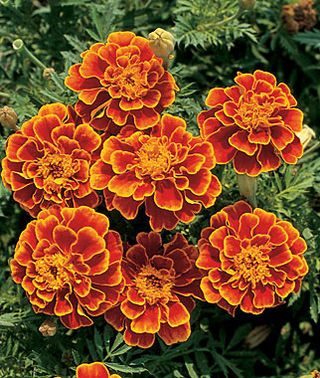
Image source: Pinterest
Marigold flowers have a distinctive appearance that sets them apart from other common garden flowers. Here are some key features that define the marigold flower’s appearance:
#1 Petals
Marigold flowers have multiple layers of petals that form a rounded, daisy-like shape. The petals are generally pointed at the tips and can range in color from yellow and orange to red, pink, white, and blue.
#2 Center
The center of a marigold flower is usually dark brown or black and has a distinctive raised texture. Some marigold varieties also have a small button-like center surrounded by a ring of petals.
#3 Size
The size of a marigold flower can vary depending on the variety, but most commonly they are 2-3 inches in diameter.
#4 Leaves
Marigold plants have bright green, fern-like leaves that are slightly hairy to the touch.
Varieties of Marigold Flower
Marigold flowers come in different varieties, each with its unique characteristics and features. The most common types of marigolds include:
#1 African Marigolds
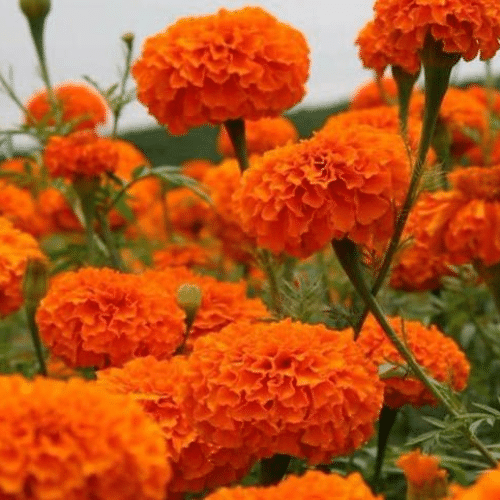
Image Source: Pinterest
These have large, showy blooms in shades of yellow, orange, and gold. They grow to about three feet tall and are commonly used as cut flowers.
#2 French Marigolds
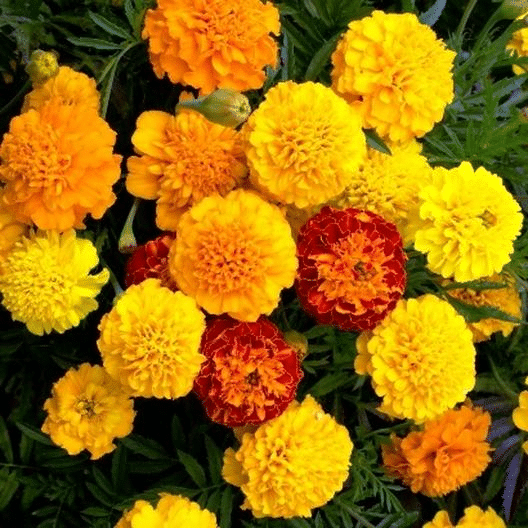
Image Source: Pinterest
These are smaller than the African marigolds, with dainty flowers in shades of yellow, orange, red, and bicolors. They grow to 12 inches tall and are great for borders and containers.
#3 Signet Marigolds
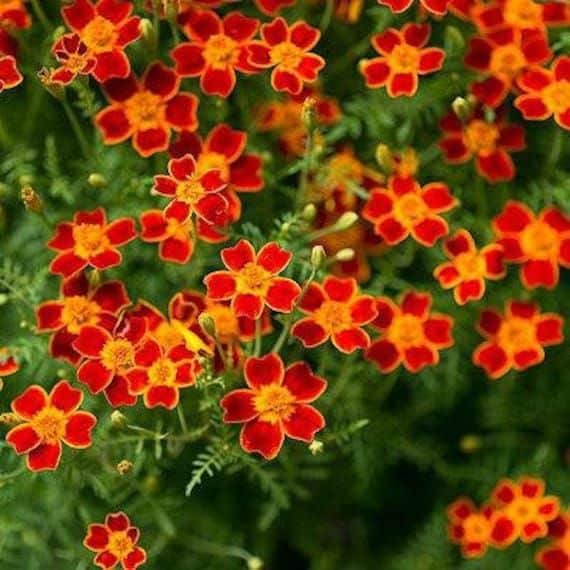
Image Source: Pinterest
These have small, edible flowers in shades of yellow and orange. They have a bushy growth habit and are often used as bedding plants.
#4 Triploid Marigolds
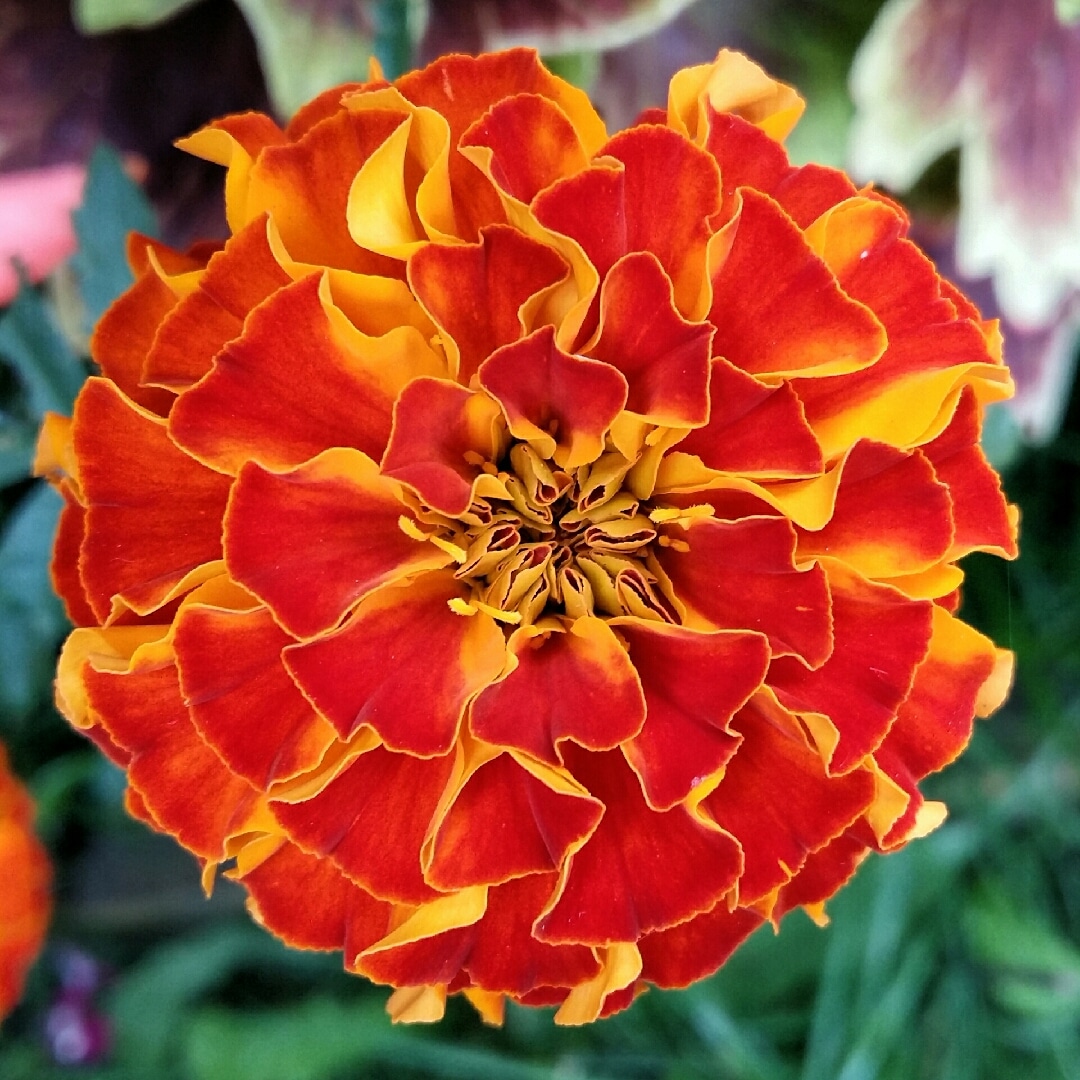
Image Source: GardenTags
Triploid marigolds are a cross between African and French marigolds, with large, double blooms in a range of colors. They can grow to two feet tall and are great for adding color to borders and beds.
Different colors of Marigold Flowers
Marigold flowers come in a variety of colors, each with its own unique characteristics and features. Here’s a breakdown of the different colors of marigold flowers:
1. Yellow Marigold Flowers
2. Orange Marigold Flowers
3. Pink Marigold Flowers
4. Red Marigold Flowers
5. Blue Marigold Flowers
6. White Marigold Flowers
#1 Yellow Marigold Flowers
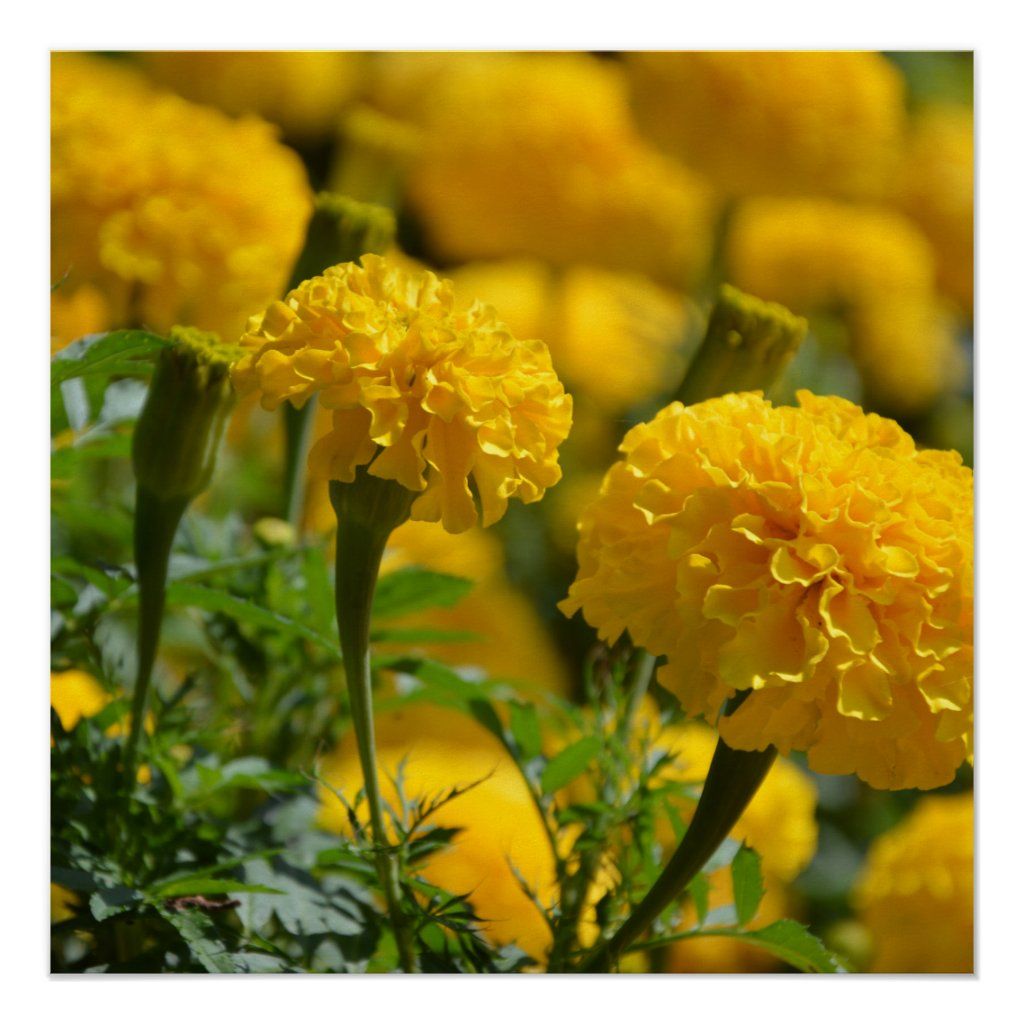
Image Source: Pinterest
These are the most common type of marigold flowers and are known for their bright, sunny color. They typically bloom in the summer and fall and can grow to 2 feet tall. Yellow marigold flowers are easy to grow and maintain, making them a great choice for beginners.
#2 Orange Marigold Flowers
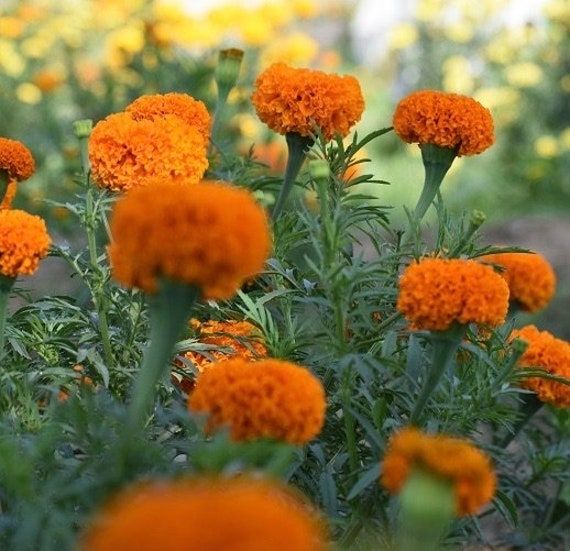
Image Source: Pinterest
These flowers are similar in appearance to yellow marigold flowers but have a more vibrant orange hue. They are also easy to grow and maintain and are often used for decorative purposes in gardens and floral arrangements.
#3 Pink Marigold Flowers
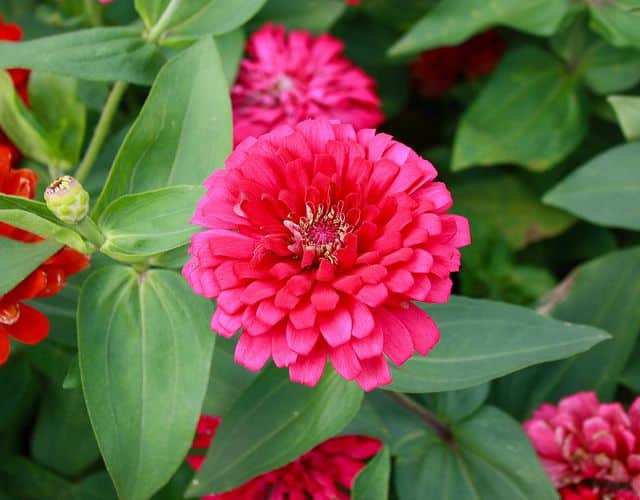
Image Source: Pinterest
These flowers have a soft, delicate pink hue, and are often used to add a pop of color to gardens and floral arrangements. They are slightly more difficult to grow than yellow and orange marigold flowers and require more care and attention.
#4 Red Marigold Flowers
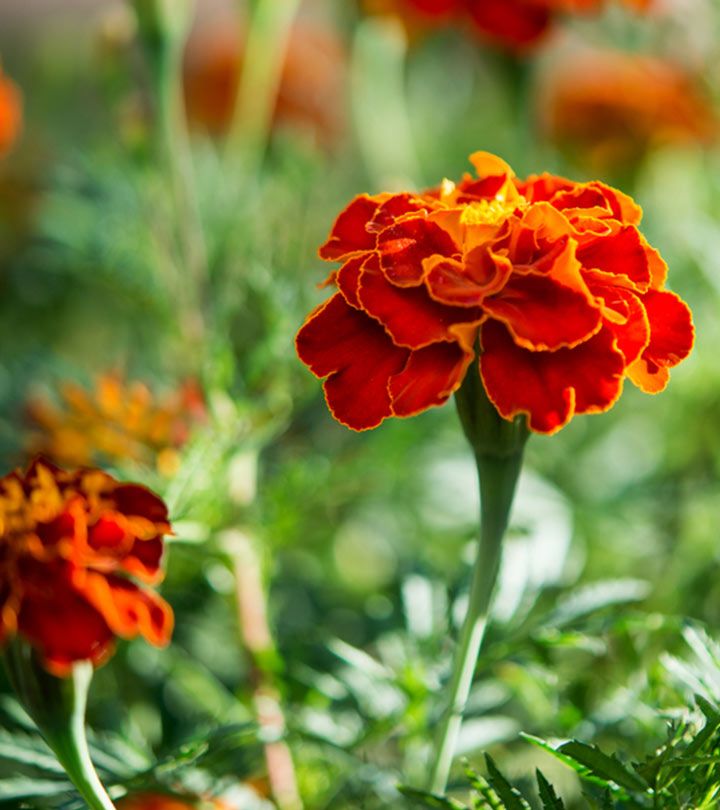
Image Source: Pinterest
These flowers have a deep, rich red color and are often used for decorative purposes in gardens and floral arrangements. They require more care and attention than yellow and orange marigold flowers but are well worth the effort.
#5 Blue Marigold Flowers
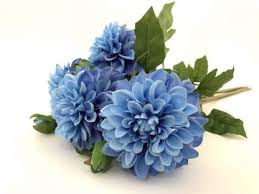
Image Source: Flipkart
These are rare and unusual types of marigold flowers, with a unique blue hue. They require specific growing conditions and are more difficult to grow than other types of marigold flowers.
#6 White Marigold Flowers
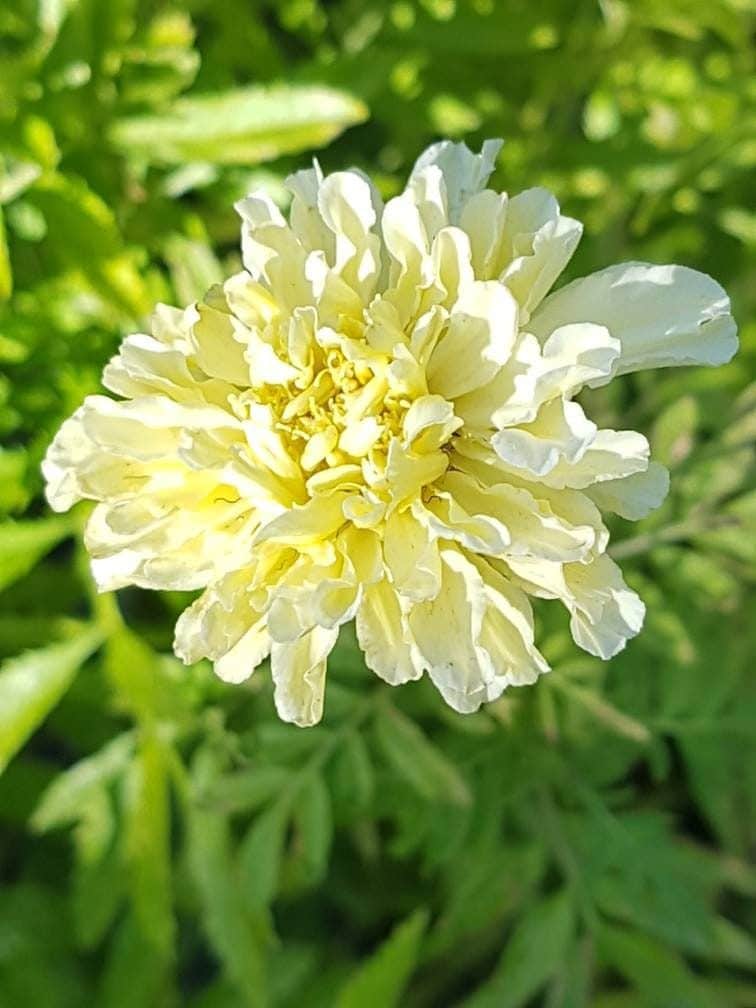
Image Source: Pinterest
These pure, crisp white flowers are often used to create contrast in gardens and floral arrangements. They require more care and attention than yellow and orange marigold flowers but are worth the effort.
When choosing marigold flowers for your garden, consider factors such as growing conditions, maintenance requirements, and overall aesthetic appeal. Some marigold flowers may be better suited to certain growing conditions or gardening styles, so research before selecting.
Does a Marigold Flower Come Back Every Year?
Marigolds are annual flowers that complete their life cycle in one growing season. They typically grow, flower, and produce seeds before dying off in the fall or winter. However, some gardeners have reported success in overwintering marigold plants in warmer climates, allowing them to return the following year.
If you reside in a region with mild winters and want to try overwintering your marigolds, you can take a few steps to improve their chances of survival. These include:
- Provide adequate water: Marigolds need regular watering to thrive, so keep the soil moist throughout the winter.
- Protect from frost: Covering your marigolds with a frost blanket or other protective material can help prevent damage from freezing temperatures.
- Prun back: Cutting back the foliage of your marigold plants can help them conserve energy and survive the winter.
Note: Overwintering marigolds tend to kill the flowers. If you need to know whether your marigolds will survive the winter, it’s best to treat them as annuals and replant new ones yearly. For more care and garden tips for house plants, speak to an expert!
Where Do Marigold Flowers Grow
Marigold flowers are popular garden plants native to Mexico and Central America, now grown worldwide. They prefer well-draining soil and full sun but can tolerate some shade. Marigolds are low-maintenance and an ideal choice for beginner gardeners. They can also be used as companion plants to repel pests and attract beneficial insects to your garden.
What Are The Nutritional Value of Marigold Flower?
Marigold flowers aren’t just ornamental flowers for your garden decor; they are equally packed with nutritional value when consumed to enhance health benefits.
- They are rich in iodine, manganese, carotene, etc., which boosts cell regeneration and hormone production.
- Flowers contain lutein, a carotenoid essential for maintaining healthy eyesight. It also contains nucleoproteins and glycoproteins, two compounds that encourage skin healing.
- Marigold florets are anti-bacterial, anti-fungal, and anti-inflammatory, effectively treating mouth and throat sores.
Conclusion
Marigold flowers are a vibrant and popular addition to any garden. With their range of colors and unique features, you have varieties to choose from for your gardening needs. They also serve as companion plants to repel pests and attract beneficial insects. Their medicinal/nutritional benefit is also appealing. So, why not grow marigolds in your garden this season and enjoy their beauty and benefits?



